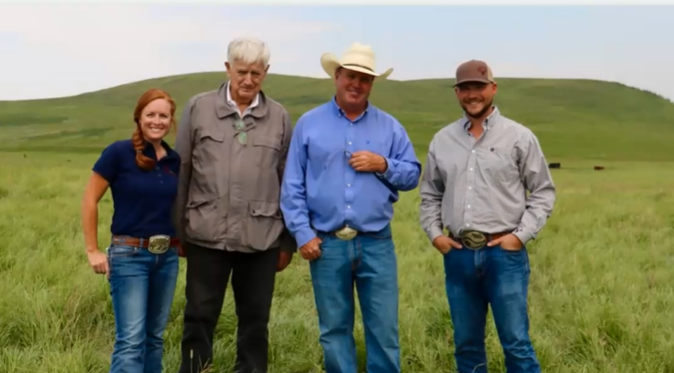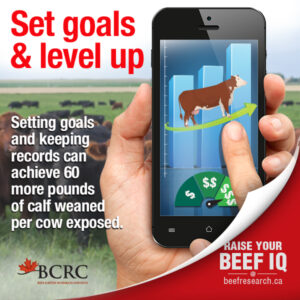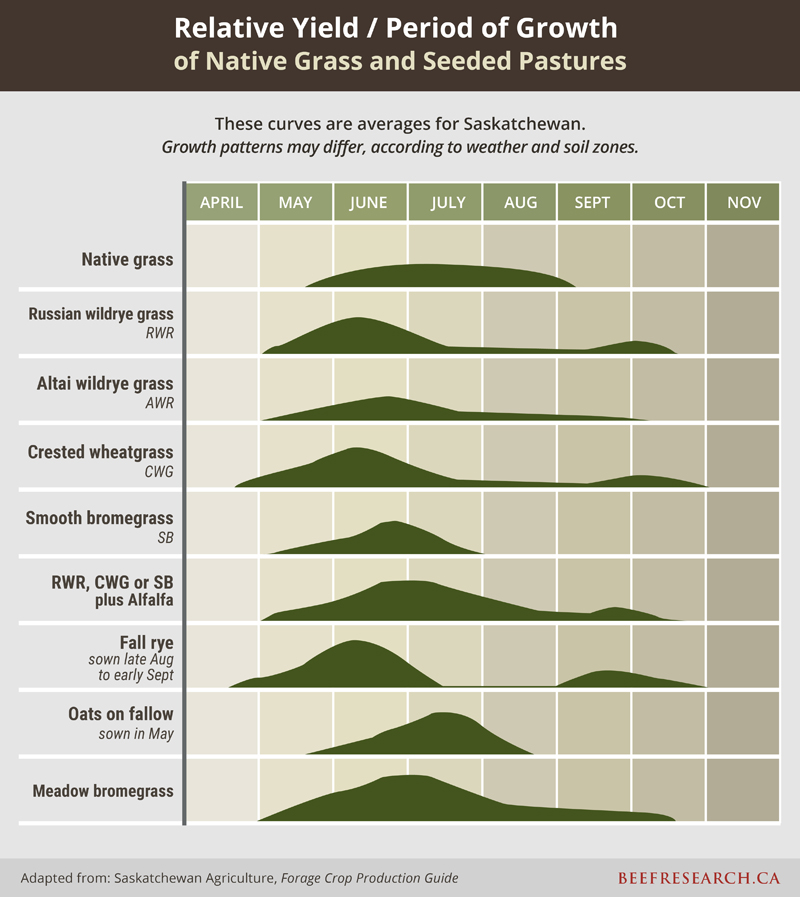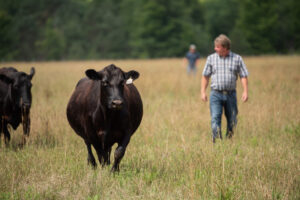Five Management Tips To Make a Big Impact in Small Herds 🎙️
CLICK THE PLAY BUTTON TO LISTEN TO THIS POST:
Listen to more episodes on BeefResearch.ca, Spotify, Apple Podcasts, Amazon Music or Podbean.
There are many producers with small herds across Canada. In fact, in 2021 31% of farms with cattle reported having 32 head or less and 22% have between 33 and 72. But what specifically defines a “small herd?”
A small herd likely means something different depending on the region, available resources and how producers choose to define their operation. Commonalities across most small herds include being family-owned and operated with fewer than 30 head of cattle, no employees on the farm or limited part-time help with the bulk of income coming from off-farm employment. A small herd may be a well-established operation or perhaps a new venture beginning to build the herd.
Being a smaller operator can pose challenges when managing a beef herd. Time is often limited and, as with most operations, the purse strings can be tight. Because of this, getting the most bang for your buck is important.
In 2021, 53% of farms with cattle in Canada reported having 72 head or less.
– Statistics Canada. Table 32-10-0167-01, Selected commodities by size, Census of Agriculture historical data
Here are five management tips that can make a big impact on your bottom line:
Tip #1: Keep records. Knowing your starting point is essential before determining where you want to go.
Keeping records to make future decisions and set clear achievable goals is extremely valuable. When you have a smaller herd, it’s especially important that every animal pulls their weight and is an asset. Identifying cows that are either aggressive, poor mothers or are not helping to meet your production goals should be identified so they can be culled. As a new or small herd producer, keeping detailed records at calving such as maternal behaviour, conformation abnormalities and dystocia incidences can help to make better culling decisions and reduce the risk of undesirable genetics proliferating through your herd. Keeping records on temperament during calving (and other times that require handling), calving ease and calf performance allows you to pick out the shining stars from the problem animals and allows you to make informed culling decisions to benefit the future herd.
Learn more and get started with record keeping:
- Introduction to Farm Record-Keeping (BCRC webpage)
- Keeping Records That Help Make Profitable Decisions (BCRC post)
- Breeding Goals: Practical Genetics for Beef Production – Using your own records to understand your farm (BCRC webinar)
- Setting Records – Calving Season Data Collection (BCRC webinar)
- Record Keeping for Forage and Grassland Management (BCRC webinar)
- Cow-Calf Production Indicators Calculator (BCRC calculator)
Remember the GOLD management indicators: Growth of calves; number of Open cows; Length of calving season and calf Death loss.
Here’s what one producer had to say on Twitter:

Mark Hoimyr, @boxhfarm
“Grass management and handling skills are important,” Mark says. But he emphasizes keeping good financial and economic records give you “the roadmap to see where your time and attention should be directed. I would expect this would be doubly important for smaller scale herds.”
Tip #2: Develop a grazing plan. Know what you have and use it to maximize future potential.
When grazing cattle, there are many factors to consider in order to utilize the land to its full potential year after year. It is important to understand the carrying capacity of your field – how many animals can be sustained on that area for how long? Knowing how much forage you have available can prevent overgrazing and optimize feed utilization. Having this information allows you to better design a grazing plan to get the most out of your pastures for the health of the herd and forage stand. Strategies like temporary fencing allow you to section your field and graze the animals over a designated area without having to invest in a permanent fence.
Pasture 101 covers a wide range of information and practical tools to consider when thinking about your grazing goals. When it comes to grazing management, know what you have and make a plan.
Grazing plan resources:
- Carrying Capacity Calculator (BCRC calculator)
- Cracking the Code on Grazing Management Terminology (BCRC post)
- How to Develop a Grazing Plan (BCRC webinar)
- Farm Resilience Mentorship Program (Canadian Forage & Grassland Association)
Here’s what producers had to say on Twitter:
Trevor Branvold, @gbtangus
“Good [grazing] management is equal to tripling your actual land base. Efficient genetics suited to your environment is another. Keep overhead to an absolute minimum (buying in feed is not as expensive as it seems on the surface).”
Dwane Morvik, @DwaneMorvik
“Better grass/grazing management, well built/designed livestock handling yards and buy the best breeding stock you can afford. the rest you can hire out for most things.”
Tip #3: Focus on cattle handling. Your time is valuable and your safety is non-negotiable.
Many farmers enjoy working cattle, but others (and their families) may find this is when tensions are most high. Keeping everyone cool, calm and collected when handling cattle not only reduces the stress on your cattle, but also reduces stress for everyone on the job. When cattle are stressed, they release more stress hormones which can mask underlying issues. Good handling practices improve animal health and welfare. Reducing stress results in calmer animals, which can allow producers to be better able to properly access and assess cattle.
Practical Tips – Staying quiet can be the biggest tool to reduce the stress on cattle. And while it can be a large overhead cost to get a good handling system in place, many producers have seen major benefits to having proper handling facilities. These changes don’t happen overnight but the benefits to keeping you, your family and your animals calm and safe is worth the investment.
Here’s what one producer had to say on Twitter:

Tracy Doonan, @outinthefield
“We were never sorry we put in a working tub and working chute. It seemed like a lot of cash but as my dad told me, ‘It’s cheaper than a week in the hospital’.”
Tip #4: Define the calving season. Establishing a clear calving period can benefit both your management and bottom line.
A cow should have a calf every year. While that is a straightforward and simple statement, cattle producers know it takes effort, planning and management to make this happen. One way to achieve this goal is to establish well-defined breeding and calving seasons. For example, defining your calving period to a controlled 60–90-day period has been shown to improve uniformity of your cattle for marketing purposes, allows your breeding herd adequate time to recover before re-breeding, reduces labour, improves weaning weights and allows you to time vaccinations more accurately. A more uniform calf crop also provides the opportunity to sell calves through calf club sales to market larger, more appealing groups of calves to feeders.
There may be situations where marketing strategies lend themselves to a calving season that differs in timing and length. Those management decisions need to be evaluated and determined by each individual producer in a way that suits the operation’s goals and marketing plan.
Additional calving season resources:
- Value of Calving Distribution Calculator (BCRC calculator)
- Calving Seasons (BCRC webpage)
- Calving & Calf Management (BCRC webpage)
Read about two producers’ experiences with shifting their calving season from 12 down to six weeks and from winter to fall calving:
How (and Why) These Eastern Canadian Cow-Calf Producers Changed and Defined Their Calving Periods
Tip #5: Invest in building a team. Farming does not have to be a one-person show.
Extension specialists, nutritionists, vets, accountants or farm business specialists, among other professionals in your area can serve as invaluable resources to help you succeed. Investing time into these relationships allows these individuals to know your herd, understand your needs and help you through challenges.

For example, building a relationship with your local veterinarian creates the foundation for a Veterinary-Client-Patient-Relationship (VCPR). Having a vet who knows you and your goals as well as your specific herd and environment helps them to better diagnose potential issues, develop a specific treatment management plan and vaccination program that is tailored to you, your farm and your animals.
Further, work with nutritionists who understand regional nutrition deficiencies and can help you balance a diet. Extension specialists or local forage and grassland associations can help highlight common challenges for your region. Farm business specialists can look at the books and potential identify opportunities to improve your bottom line you may have not considered before. Even looking to neighbours and other producers, can help streamline your management and provide a sounding board for ideas. Developing these relationships facilitates a team dynamic to support you when questions arise and to help identify key opportunities.
Learn more about the team approach:
- Implementing Management Practices that Pays Off (BCRC post)
- Until the Cows Come Home: Five Strategies to Stop Sickness this Fall (BCRC post)
Top Tips from Producers
Canadian beef producers have a variety of different suggestions for making small herds work effectively. Here are a few ideas shared with @beefresearch via Twitter:
Many producers chimed in with tips on investing in capital infrastructure compared to hiring things out. Ontario producer Barry Potter, @PotterBarry, says, “We outsource all our equipment work. I am blessed to have farms close by that do it for me as a revenue source for them.”
Saskatchewan producer Keith Guy, @7barlivestock, shared a tip for small and large herds alike. “Don’t have to own all the equipment. Some jobs can be hired out effectively. Ie. Trucking and new fence building are the two easiest to hire out. That goes for larger ranches too.”
VBP+ certified producer Barb Kristjansson, @bkristjansson1, shared some ideas on Twitter: “The economics of a smaller herd (50-60) don’t allow for new equipment. 40 series tractor and 15-year-old haybine, 535 baler. Works great when maintained.” She also adds that building relationships is helpful. “Land base is usually less as well, so a good relationship with someone that has hay to sell and/or straw to bale is priceless. Don’t shop around for cheapest every year, establish a relationship and maintain it.” Marketing smaller lots can be a challenge or opportunity. “Our cattle are marketed locally at presort sales to take advantage of large groups. Hauling is done by ourselves, pastures and sale barn are close.”
Sharing or reprinting BCRC posts is welcome and encouraged. Please credit the Beef Cattle Research Council, provide the website address, www.BeefResearch.ca, and let us know you have chosen to share the article by emailing us at [email protected].
Your questions, comments and suggestions are welcome. Contact us directly or spark a public discussion by posting your thoughts below.


